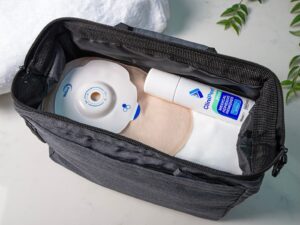Urinary incontinence is very common, one in three people in the UK will experience incontinence as some point in their lifetime. So, if you think you’re suffering from urinary incontinence you’re not alone.
The first step in managing and treating incontinence is to talk to your GP. They’ll be able to tell you if you’re showing symptoms of urinary incontinence, investigate the cause and suggest treatment options.
It may be helpful to make a record of when you leak urine and take this with you to your appointment.
Our Bladder Diary is free to download and can help you keep track of leaks, how often you visit the toilet and how much you are drinking.

Treatments for urinary incontinence
Depending on the type of urinary incontinence you suffer from there are several medications available that may help. Surgical treatments for incontinence are also available and it’s worth discussing whether these interventions are suitable for you with your doctor. There are also a variety of products available to manage your condition prior to or instead of medical or surgical treatments.
Catheters
Catheters are flexible tubes that are inserted into the bladder to allow urine to drain freely. There are two types of catheters: intermittent and indwelling.
Intermittent catheters are used in cases where the bladder does not empty completely on its own. They are temporarily inserted into the bladder when the urine needs to be drained. This method helps prevent urinary tract infections and kidney problems.
Indwelling catheters are left in place for extended periods, either through the urethra or via a suprapubic route, which involves a small incision in the lower abdomen. While indwelling catheters are typically considered a last resort due to higher infection risks, the suprapubic option offers easier management and a reduced infection rate for long-term use.
Sheath systems
Urinary sheaths are also called condom catheters and like a condom they are worn over the penis. The silicone or latex material sticks snugly around the penis and the end is attached to a tube and drainage bag which can be fixed to the thigh or lower leg. Because they are worn on the outside there is less risk of infection compared to an indwelling catheter.
Vaginal devices
Are designed to help with stress incontinence. They work by putting a little pressure on the bladder neck which helps to prevent leakage. They are ideal for women who perhaps only leak when they play sport but should be used with the advice of a Continence Nurse or physiotherapist.
Ring pessaries
These are sometimes inserted for uterine prolapse and can also help with incontinence. There are a wide range of pessaries available, and some are specially designed to help with stress incontinence.
Incontinence pads and handheld urinals
Incontinence pads adhere to the user’s underwear and are designed to absorb urine. They are suitable for all genders, pads are available in various sizes and absorbency levels, and can be bought online, in supermarkets and chemists.
Handheld urinals enable people to relieve themselves when they are unable to reach a bathroom due to mobility issues or incontinence. There are many types of handheld urinals available, some with drainage bags attached for ease of use.





